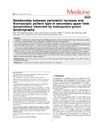Identificador persistente para citar o vincular este elemento:
https://accedacris.ulpgc.es/jspui/handle/10553/73603
| Campo DC | Valor | idioma |
|---|---|---|
| dc.contributor.author | Medina Rodríguez, María Elena | en_US |
| dc.contributor.author | de-la-Casa-Almeida, María | en_US |
| dc.contributor.author | Mena-Rodríguez, Antonio | en_US |
| dc.contributor.author | González-Martín, Jesús María | en_US |
| dc.contributor.author | Medrano-Sánchez, Esther Mª | en_US |
| dc.date.accessioned | 2020-07-02T10:35:09Z | - |
| dc.date.available | 2020-07-02T10:35:09Z | - |
| dc.date.issued | 2020 | en_US |
| dc.identifier.issn | 1536-5964 | en_US |
| dc.identifier.other | Scopus | - |
| dc.identifier.uri | https://accedacris.ulpgc.es/handle/10553/73603 | - |
| dc.description.abstract | To ascertain the relationship between the perimetric differences obtained between the limbs and the type of fluoroscopic pattern observed by Indocyanine green (ICG) lymphography in patients with upper limb lymphedema.A correlational descriptive study was carried out in 19 patients with upper limb lymphedema secondary to breast cancer. The perimetric increase was recorded in 11 anatomical regions after ICG injection, fluoroscopic patterns were identified using an infrared camera. The ICG patterns were categorized into worse (stardust, diffuse) or better (linear, splash) patterns.The pattern coincidence between the anterior and posterior regions of the edematous extremities was 45%. At the wrist level, a difference of 2 cm was associated with the presence of a worse fluoroscopic pattern, whereas perimeter differences of 4.25 cm in the elbow and 2.25 cm in the arm (12 cm from the epicondyle) were associated with the presence of a better fluoroscopic pattern.The perimetric differences observed between the healthy and affected upper limbs in 4 specific anatomical areas allowed us to predict the type of fluoroscopic pattern. ICG lymphography has facilitated the study of the posterior regions of edema, which are difficult to visualize using other imaging techniques. | en_US |
| dc.language | eng | en_US |
| dc.relation.ispartof | Medicine | en_US |
| dc.source | Medicine [EISSN 1536-5964], v. 99 (24), (Junio 2020) | en_US |
| dc.subject | 32 Ciencias médicas | en_US |
| dc.subject.other | Indocyanine green | en_US |
| dc.subject.other | Lymphatic vessels | en_US |
| dc.subject.other | Lmphedema | en_US |
| dc.subject.other | Lymphography | en_US |
| dc.title | Relationship between perimetric increase and fluoroscopic pattern type in secondary upper limb lymphedema observed by Indocyanine green lymphography | en_US |
| dc.type | info:eu-repo/semantics/Article | en_US |
| dc.type | Article | en_US |
| dc.identifier.doi | 10.1097/MD.0000000000020432 | en_US |
| dc.identifier.scopus | 85086622093 | - |
| dc.contributor.authorscopusid | 57217173448 | - |
| dc.contributor.authorscopusid | 55175148800 | - |
| dc.contributor.authorscopusid | 57217174339 | - |
| dc.contributor.authorscopusid | 57217173438 | - |
| dc.contributor.authorscopusid | 55175481800 | - |
| dc.identifier.eissn | 1536-5964 | - |
| dc.identifier.issue | 24 | - |
| dc.relation.volume | 99 | en_US |
| dc.investigacion | Ciencias de la Salud | en_US |
| dc.type2 | Artículo | en_US |
| dc.utils.revision | Sí | en_US |
| dc.date.coverdate | Junio 2020 | en_US |
| dc.identifier.ulpgc | Sí | es |
| item.fulltext | Con texto completo | - |
| item.grantfulltext | open | - |
| crisitem.author.dept | Departamento de Ciencias Médicas y Quirúrgicas | - |
| crisitem.author.orcid | 0000-0002-8230-4491 | - |
| crisitem.author.fullName | Medina Rodríguez, María Elena | - |
| Colección: | Artículos | |
Citas SCOPUSTM
8
actualizado el 08-jun-2025
Citas de WEB OF SCIENCETM
Citations
7
actualizado el 08-jun-2025
Visitas
109
actualizado el 09-nov-2024
Descargas
115
actualizado el 09-nov-2024
Google ScholarTM
Verifica
Altmetric
Comparte
Exporta metadatos
Los elementos en ULPGC accedaCRIS están protegidos por derechos de autor con todos los derechos reservados, a menos que se indique lo contrario.
